Coin Rarities & Related Topics: News and Analysis regarding scarce coins, coin markets, and the coin collecting community #268
A Weekly CoinWeek Column by Greg Reynolds….
Broadly defined, a wide variety of items fall into the category of pattern, experimental and trial pieces. Patterns, narrowly defined, are design concepts that should logically have been considered, were considered but never adopted for regular coinage, or not yet adopted when the respective patterns were made. The 1882 Shield Earring patterns of silver denominations are generally regarded as among the most artistically appealing of all. A Shield Earring pattern quarter, in silver, will be offered at auction by Heritage during the CSNS Convention in Schaumburg, Illinois, this April.
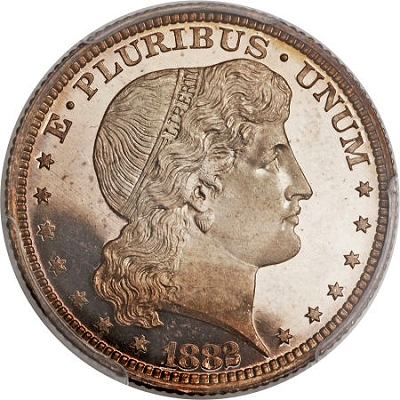
There also exist Shield Earring half dollar and silver dollar patterns, with almost the exact same designs as that of the quarter. Shield Earring pieces are among the most famous of all U.S. patterns and the offering of just one can be the highlight of a coin auction.
Schoolgirl silver dollar patterns are about as famous, though there are no Schoolgirl quarters or half dollars. There are Washlady quarter, half dollar and dollar patterns, plus Washlady dimes, and these are widely admired as well. Among U.S. patterns of silver denominations, the most artistically distinctive survivors date from the 1870s and ’80s.
Amazonian patterns are in the same category of fame as Shield Earring, Washlady and Schoolgirl silver denomination patterns. The Amazonian silver denominations are among my personal favorites. Amazonian gold denomination patterns have a different obverse.
Amazonian and most other gold denomination patterns tend to be collected in copper, as gold denomination patterns in real gold are extraordinarily rare. The most famous patterns of all, however, are made of gold, the least rare being the Ultra High Relief 1907 Saint Gaudens $20 pieces. Ultra High Reliefs are more elegant and sculpturally extravagant counterparts to regular 1907 High Relief Saints, which have the status of coins.
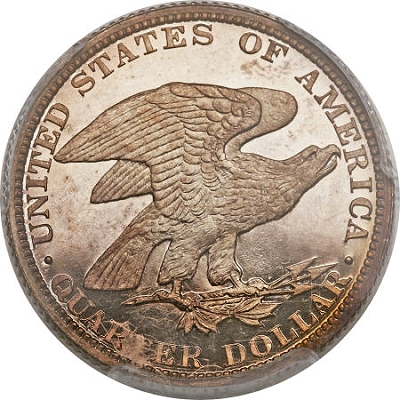
Another famous 1907 double eagle pattern, with an Indian Head obverse, is unique and very different from regular Saints of any variety. That piece is also based upon design concepts of Augustus Saint-Gaudens and may be the most valuable, privately owned numismatic item. Its obverse is similar to the adopted obverse design of Indian Head eagles, though it’s more elaborate. The 1907 date, in Roman numerals, is on the reverse, below a flying eagle. An image of the obverse of this pattern serves as the mascot for the PCGS CoinFacts site.
While that piece and Ultra High Relief Saints are often discussed by veteran collectors, most coin enthusiasts, even those with years of collecting experience, have never held a pattern that was struck in gold. Many people have held or at least seen 1856 Flying Eagle cents, of which more than a thousand exist. If 1856 Flying Eagle cents are to be classified as patterns, as legislation authorizing small cents was not passed until 1857, these are famous and intensely demanded patterns. Indeed, thousands of collectors seek to obtain 1856 Flying Eagle cents ‘as if’ they are regular coin issues.
While Liberty Head nickels weren’t issued until 1883, there exist 1882 nickel patterns with the same design as the regular coins that were formally issued in 1883. These 1882 Liberty nickel patterns are famous, too, and, like other patterns mentioned here, fall into the category of ‘patterns, narrowly defined.’
Though perhaps not the most famous of all pattern designs, the Shield Earring design is curiously distinctive. During the 19th century, a shield of a particular design appeared on most U.S. coin types of silver and gold coins. The general design of this shield is an emblem that was often seen in the U.S. during the 19th century, in art, advertising and print publications.
Such a shield was also part of the designs of Two Cent pieces (1864-73) and Shield nickels, which date from 1866 to 1883. In 1860, a small shield was added to the reverse design of Indian cents.
On Liberty Seated silver coins, Miss Liberty is holding a shield of this design. On Draped Bust Heraldic Eagle and Capped Bust silver coins, such a shield is implanted on the chest of the eagle on the reverse of each. On all 19th century quarter eagles ($2½ gold coins), half eagles ($5 gold coins), eagles ($10 coins) and double eagles ($20 coins), a shield of this form is on the eagle’s chest in the respective reverse designs.
The design of Shield Earring patterns is extremely unusual in that the shield artistically appears as an earring that Miss Liberty is wearing. Certainly, this was a novel and intriguing way of incorporating the shield into the design.
A complete set of Shield Earring patterns would comprise of six pieces. Quarter dollar, half dollar and silver dollar denominations were struck in silver and in copper. The exact purposes of the copper pieces are not entirely known by researchers now.
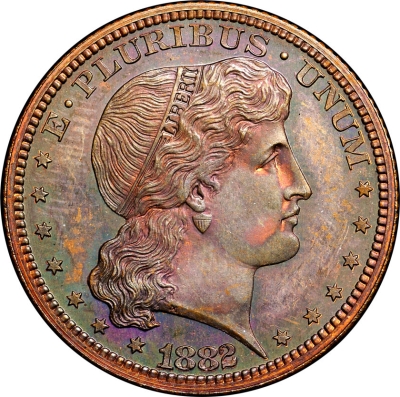
There are three likely reasons for copper patterns of silver denominations. The first was to test or align dies, or to see how a proposed pair of designs appears in coin form before using silver (which was costly). The second reason was to produce pieces exclusively for collectors, some of whom very much like copper patterns of silver denominations.
The third reason, which is perhaps the most logical, stems from the reality that there was a limit to the amount of silver that would or could be used for each particular type or group of patterns (or for patterns in general) during a given time period. Large quantities of silver were never allocated for pattern production.
Those producing Shield Earring patterns probably wished to make more than the maximum number that they could mint in silver, so they made them in copper, too. Silver and copper pieces could have been handed to influential people, who might have had an effect, directly or indirectly, on coinage legislation. A Treasury Department official or a member of a U.S. Senator’s staff, for example, may have viewed a quarter pattern in copper and imagined how the same design would appear in silver.
Generally, as copper was (and still is) so much less expensive than silver, U.S. Mint officials conserved resources by minting some pieces in copper rather than producing all patterns of silver denominations in silver. Patterns were often distributed for free.
Rarity of Shield Earring Quarters
Saul Teichman, a leading researcher of patterns, lists nine Shield Earring quarters in silver. More than one cataloguer at Heritage hints that Saul’s list may include duplication.
The “gunmetal blue-gray toned” piece, which Julian Leidman handled in the early 1980s, could be either the Rothschild-Queller piece, the Jones Beach piece or one of the others. At least three have blue and gray tones, which become more evident under particular lighting conditions.
Although there could realistically exist as many as 11 Shield Earring quarters in silver, I suggest that just seven or eight are currently known to the coin collecting community. It seems that there are seven in copper as well. In sum, there survive at least 14 Shield Earring quarter patterns. One of the silver pieces is in the Smithsonian.
Rogers Fred
The silver Shield Earring quarter pattern that will be offered in April may be the finest known, though another is a little more attractive. This piece was formerly in the epic collection of patterns formed by Rogers M. Fred, Jr. Yes, this is an unusual name. According to the site of Hake’s Americana & Collectibles, Fred actively collected dozens of 20th century comic books, some of which are currently being disbursed.
On Nov. 13, 1995, Bowers & Merena (New Hampshire) auctioned the Fred Collection in New York, along with other consignments. I attended the sale and was stunned by this coin. It is or at least was then very pretty! It has since toned a little more and I am not prepared to draw a conclusion about its current appearance. I remember raving about it in 1995, as did Saul Teichman, Andy Lustig and Jay Parrino. It was more than just dynamic; it glistened wonderfully.
The Fred Shield Earring quarter was then PCGS certified as Proof-66. Although grade-inflation is a factor, it could be fairly argued that this piece deserved a 67 grade in the 1990s and was thus then undergraded. I remember that some of us at the auction discussed the notion that it may have deserved a 67 grade, though there was not a consensus on this point.
The Fred Collection Shield Earring quarter is now PCGS certified as ‘Proof-67 Deep Cameo’ and is in a holder that is less than three years old. In 1995, I noted that it had fantastic mirrored surfaces. The russet toning was natural, even, mild and pleasant.
In 1995, it realized $24,200. The successful bidder was a Long Island dealer who has since left the coin business. Andy Lustig was the underbidder. A sophisticated collector from Indiana was the second underbidder, at the $22,000 level.
“When this silver Shield Earring sold for $24,200 in the Fred sale, only two patterns brought a higher price: a silver Schoolgirl dollar went for $39,600 and the silver Shield Earring dollar, $28,600. It brought more than his aluminum Amazonian half, $17,600, and Amazonian dollar, $22,550,” …… “It came as no surprise that PCGS upgraded Fred’s Shield Earring quarter from 66 at the time to 67 a few years later,” Teichman adds.
Rothschild-Queller
In 2003, Stack’s (New York) auctioned Randolph Rothschild’s collection of patterns, an event that I covered in detail for Numismatic News newspaper. Most or all the pieces were not certified. This was an epic collection of patterns, with gold denominations struck in gold, a Schoolgirl dollar, other Shield Earring pieces, Amazonian patterns in multiple metals, etc.
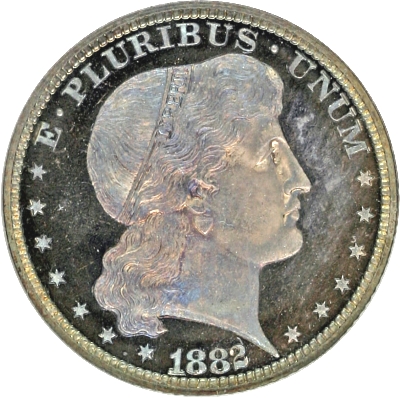
For Rothschild’s Shield Earring quarter in silver, David Queller was the successful bidder. This was even more attractive than the Fred piece. The blue, red and russet toning, frosted devices and overall glitter were mesmerizing. Admittedly, in 2003 I didn’t fully note some contact marks on the reverse about the arrow heads and in the field below the eagle.
I paid more attention to these contact marks and other minor imperfections in January 2009, when Queller’s pattern collection was auctioned at the FUN Convention in Orlando. Even so, I was still overwhelmed by this piece. In 2008, NGC graded it as 67 and, unsurprisingly, added a star for eye appeal.
Richard Burdick was the successful bidder. Richard echoes the traditional view that “the Shield Earring, Schoolgirl, Washlady and Amazonian pieces are the big four groups of silver patterns, the most desirable because of their artistic merit.”
For the Rothschild-Queller piece, Burdick was acting as an agent for the buyer. On Jan. 7, 2009, it realized $126,500, a record price for a Shield Earring quarter. “The Queller pattern was drop-dead gorgeous, aesthetically unequaled,” Burdick declares.
This Shield Earring quarter was later submitted to PCGS, where it was downgraded to “65+.” It was undergraded by PCGS, in my view.
This pattern has never been dipped and probably never cleaned. The already mentioned imperfections in one area of the reverse are barely noticeable and, if these were not present, this pattern would qualify for a 68 grade. It is really beautiful!
Jones Beach
At the January 2007 FUN Convention in Orlando, Heritage sold the Jones Beach Collection of patterns, another amazing assemblage though it has been largely forgotten. If all other factors are about the same, a collection with a true human name will attract more attention and is more likely to be remembered than a collection with a code name.

The Jones Beach Shield Earring quarter in silver was and probably still is NGC certified as Proof-67. On Jan. 3, 2007, it realized $43,125.
Although it scores higher in the technical category than the Rothschild-Queller piece, it is not quite as attractive. Saul declares that the Rothschild-Queller piece is “visually stunning,” and I take his remark to be an understatement. Moreover, the Jones Beach piece does not the emotional impact of the Rothschild-Queller piece. Although I tentatively rank the Rothschild-Queller piece above the Jones Beach piece, I would really have to examine the Jones Beach piece again to draw a firm conclusion.
The Jones Beach piece was earlier auctioned by Bowers & Ruddy in May 1972. It may have been consigned by Armand Champa, who formed an epic collection of patterns, too. Champa later formed the all-time greatest collection of U.S. numismatic literature that has ever been publicly auctioned.
Eliasberg-Simpson
A silver Shield Earring quarter pattern was in the Eliasberg Collection from 1942 to 1996. Through Stack’s in New York, Louis Eliasberg acquired the John Clapp Collection in its entirety in 1942, reportedly for $100,000, a large sum at the time. This piece is believed to have been earlier in the Lorin Parmelee Collection, one of the 15 all-time greatest collections of classic U.S. coins. Parmelee’s collection was auctioned in 1890 and the catalogue pictures are a little fuzzy.
The Eliasberg piece was NGC graded 65 before 2007. It is now PCGS certified ‘Proof-65-Cameo’ with, I believe, the “Eliasberg-Simpson” pedigree cited on the label (‘insert’) inside the holder.
Julius Turoff
Saul is certain that the silver Shield Earring quarter formerly owned by the late Julius Turoff was PCGS graded 64 shortly before it was auctioned by Bowers & Merena (New Hampshire) in 1994. Previously, the Turoff piece was in an auction conducted by the firm of Lester Merkin in 1967.
My guess is that this same Turoff piece was graded as 64 by NGC, too. I already indicated that the NGC certified “Proof-67*” and the PCGS certified “Proof-65 Cameo” Shield Earring quarter are the same Rothschild-Queller piece.
Although the late Julius Turoff of Queens was best known as an officer of coin clubs and as a collector of medals, he assembled a landmark collection of patterns. According to Teichman, Turoff “continued to display his patterns at New York coin shows after he sold his U.S. coins in a Bowers & Ruddy 1976 sale.” From the 1960s to the ’90s, Jules was a frequent speaker at coin clubs on the East Coast.
Harry Bass
Although the late Harry Bass is best known as an expert in the die varieties of U.S. gold coins, he also assembled an epic collection of patterns. Most of his patterns were auctioned by Bowers & Merena in New York during May 1999.
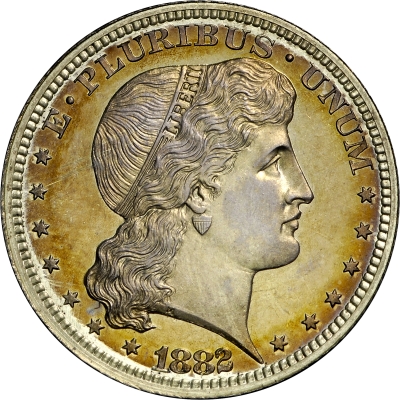
Some rarities in the Harry Bass Collection, including more than a few patterns, were not auctioned and were retained by the Harry Bass Educational Foundation. A prime example is that the Bass Collection continues to feature the unique 1870-S three dollar gold piece. Harry’s complete set of three dollar gold pieces is (or was) on display at the ANA museum in Colorado Springs.
The Bass 1882 Shield Earring quarter in silver remains in the Harry Bass Collection. The Bass Foundation’s website indicates that it was auctioned by the firm of New Netherlands in June 1970. Saul Teichman reports that Jesse Taylor’s “patterns were sold in the 1970 New Netherlands sale.”
Published pictures do not give the impression that the Bass Shield Earring quarter in silver is a gem quality coin, though it could be so. I’ve never seen it and I’m not commenting about its grade here. Also, I have never seen the one in the Smithsonian.
Concluding Thoughts
As it’s difficult to assemble an extensive and orderly collection of patterns, it may make sense for collectors of Liberty Seated coins or 19th century type coins to acquire artistic patterns to complement their respective sets of regular issues. Moreover, many varieties of patterns, broadly defined, may enhance sets of various regular issues. Liberty Seated dimes, quarters and half dollars struck in copper, with regular dies, are somewhat available and may complement ‘date sets’ or type sets. Collectors of Liberty Head gold coins likewise may be entertained by the acquisition of a few gold denomination patterns struck in copper.
Additionally, patterns that are just slightly different from corresponding regular issues are interesting. For some coin enthusiasts, acquiring them further contributes to the enjoyment of collecting 19th century regular issues.
The all-time best type set of classic U.S. silver coins, the Knoxville Collection, contained several pattern coins. These added spice and made a great type set even greater.
©2015 Greg Reynolds


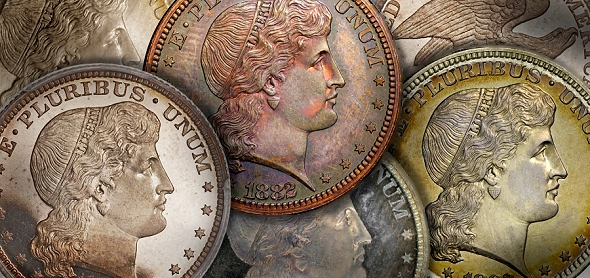



A very well written article. I appreciate that Greg takes time to describe
each of the known pieces. While I do not collect U.S. coin patterns, I do
enjoy reading about them. Greg gives a well written article that is easy to
read and follow. My favorite design is the “Schoolgirl”. Maybe one day.
What a fabulous article with great photos! The stuff numismatic dreams are made of!